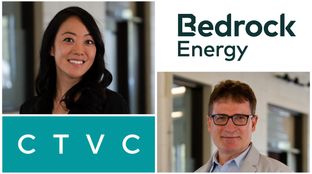
🌍 Laying down the law in the Wild West of the VCM
The White House’s new announcement clears the air about the voluntary carbon market
A Q&A with the DOE LPO director Jigar Shah and Solugen CEO Gaurab Chakrabarti
Solugen is forging ahead beyond FOAK, with a fresh conditional commitment for a $214m loan guarantee from the DOE Loan Programs Office (LPO) to build their second commercial plant in Minnesota, a “Bioforge” facility to produce bio-based organic acids. The sustainable chemicals company’s scale-up journey has been a primer in building a climate capital stack to bridge from FOAK through the “weird, awkward in between” to get to NOAK, as CEO Gaurab Chakrabarti puts it.
Meanwhile, Jigar Shah and the LPO team are also in their element, with this marking the largest biomanufacturing investment since President Biden's 2022 executive order, which aims to boost the domestic bioeconomy. Established in 2005, the LPO catalyzes commercial-ready clean energy technology, famously rescuing Tesla with a $465m loan in 2010. Recently, the Inflation Reduction Act increased LPO’s loan authority by ~$100bn, with a significant portion earmarked for U.S.-based manufacturing.
We were lucky enough to get both sides of the story from LPO Director Jigar Shah and Solugen CEO Gaurab Chakrabarti to find out how the $214m loan guarantee came together, what the diligence process looked like, and what’s next. (Learn more about Solugen’s fancy “chemienzymatic” platform in our previous profile with Solugen here).
This Q&A has been edited for length and clarity.
CTVC: Can you tell us about the loan and the criteria for getting it?
Jigar Shah: This loan came out of the Title 17 Innovative Clean Energy Program — the criteria to apply to that program is to save greenhouse gas emissions and be innovative. We have always thought that as we move away from petrochemical supply chains, a bio-approach to those essential chemicals would be helpful. The President signed Executive Order 14081 on advancing biotechnology and biomanufacturing innovation, so this represents the single largest US government investment in bioindustrial manufacturing.
The technology story here is quite strong. And the other thing that's interesting is that Solugen is co-located with an ADM facility in Minnesota. So when you think about where we're going from an electric vehicle supply chain perspective, one question is, what do we do with all that ethanol and corn infrastructure in this country? Well, here's one answer.
Gaurab: The loan itself is roughly $214m of conditional commitment for funding. The process to get the loan itself was — I'm not going to lie — pretty arduous, but in a good way. It took almost 20 months to go from first applying to conditional commitment.
The process was a very rigorous analysis of the technology and commercial piece of the business. The DOE hired four different consultants to essentially diligence the business over that time. Folks came out to the plant and saw it operate. They got to see every single number that we put on the screen and were able to build their own techno-economic model that closely resembled ours. However, they did it from a first-order set of data rather than just taking our word for it. The loan itself is an amazing diligence tool — you get this package that shows you where the business has real strengths and where there are areas of improvement. It gives you a realistic sense of where you are in the journey of bankability.
CTVC: What was the diligence process like?
Jigar: For the LPO, we require technology to show that it's working for 1,000 - 2,000 hours. Solugen has a pilot facility in Houston, where they're able to demonstrate that their technology works.
Other pieces are, their access to feedstock — do they have a short term arbitrage, or can they get access to cost effective feedstock for a long time? Also, can you find quality construction workers and operating workers to operate the facility?
And another part is doing diligence on the marketplace. It's one thing to say, Asian suppliers are apparently pricing their chemicals at X, and these guys have a cost structure that is a discount to X. But we need to compare it to the actual cost structure of some of the suppliers from Asia — what if they cut their price in half?
For some sectors, offtake is a must, but in other sectors, offtake is not something that is normal. In this sector, for instance, there are people who certainly are buying their chemicals already, but they're buying them one, two, or three years at a time — not 20 years. So we had to get comfortable that the market is deep enough already, and that enough people who have already used their product from their Houston facility are comfortable with the quality and are likely to continue to buy it.
So a lot of diligence, and very exciting to see these guys make it through that process.
Gaurab: This was a whole company effort. We standardized as much as we could, to be able to report as numerically as possible. We started with technology, where we created our own diligence analysis of the strengths and weaknesses of the technology. Then we had two different independent engineering groups affiliated with the DOE come out and do their own analysis and see where there were consistencies and inconsistencies between our analysis and theirs.
The commercial side was pretty in depth too. Effectively, they broke down the assumptions of our model based on a top-down view of the market and then a bottoms-up view of our end users and markets. We also provided commentary from the customers themselves, based on conversations that we've had with them. So it was kind of a dual-approached diligence analysis.
CTVC: What’s the structure of the loan? And what are profitability expectations?
Jigar: So, the Department of Energy provides a loan guarantee out of the Loan Programs Office, but we can either guarantee a commercial bank, or we can guarantee the Federal Financing Bank at the U.S. Treasury Department. In this case, Solugen has opted to do the U. S. Treasury Department. So the $214m will be a loan they receive from the U. S. Treasury Department.
We can only provide money against eligible costs and eligible costs are capital costs. So, all of it has to go to eligible costs. There are obviously some soft costs around building these kinds of facilities, but that has to be covered by equity.
[In terms of profitability] Solugen is able to produce these chemicals at such a low cost that they're able to actually beat Asian suppliers of the same chemicals, in the US, on price. A lot of the projects that we do, there's this technology premium that comes along with them. In this case, folks are able to save money today.
Gaurab: I'm not sure I can say the interest rate, but it's a healthy, good interest rate for the business.
And the profitability expectations are pretty high. That’s just based on the technology that we've been developing. We anticipate even with the loan, that this facility should allow the business to be profitable in the next couple of years, which is pretty remarkable — things are moving fast. For us, the profitability expectation mirrors and supersedes our Houston site's profitability, which on an asset level is already profitable. So effectively we anticipate there's going to be some benefits of scale that allow our profitability to go up.
CTVC: This wasn’t exactly a FOAK, but a second-of-a-kind facility. Why is an LPO loan the right move here?
Jigar: I think in general, people are really afraid of the concept of “first-of-a-kind.” But when you think about first of a kind, it's rarely actually first of a kind. It usually starts with something that's sustainably proven at lab-scale. In this group’s case, they had a garage-scale unit, and then pilot-scale — but it's one-tenth scale or one-fifth scale of commercial. I think this is the more responsible way to do first-of-a-kind deployments.
Gaurab: This is technically our second commercial plant, but it's our biggest commercial plant. We financed our first plant in Houston completely through equity. The purpose of going after the DOE loan here was, we were in that weird, awkward “in between,” where we've proven out that this thing works and that it's scalable, but the risk was still too high for a lot of private banks to come in.
There weren't many other options to debt finance this, because if you look at the way that business grows for Solugen, it's our ability to access this project financing or debt capital that's going to determine our success. So we reasoned that going through that DOE LPO process was the most rigorous thing we could do to show debtors and really the world that the technology was ready for primetime. For us, it wasn't just the money — it was a combination of the money, which is great, but also the validation and credibility building that you get with the DOE LPO. You can't really do that with a traditional bank.
CTVC: Looking forward, what’s the impact of this loan overall and what’s next?
Jigar: When you think about this particular company, these are two founders who met at a med school poker game and then raised $640m. I think that this is a testament to, if you do things using best practices, you can get an LPO loan within six years. One of the things that we're hoping to do in this version of the Loan Programs Office is to share with people that there is a right way to get institutional interest, trust, and buy in. I think there's a lot of people who think, 'Oh, it's impossible to get from concept to LPO in under 10 years.' I think these guys have proven that you can.
Part of this is yes, Solugen is a great story, but part of this, particularly for the CTVC audience, is that there’s a lot happening in this space and in this sector.
Gaurab: So for us, it’s a huge deal. We've put chemicals and biomanufacturing specifically on the same footing as critical minerals, energy, and hydrogen, which has never been done before.
The way we think about why this DOE loan is so critical is in three buckets: the circularity of feedstock, the efficiency of the feedstock-to-product conversion, and the local supply chain. We use biomass as our feedstock, which allows us to have carbon offset. Our integrated yield, as confirmed by the DOE, is greater than 96% yield from feedstock to product — compared to petrochemistry’s 50-60%. And we're both near our feedstock, i.e. our partner ADM, and near our customers, who are in water treatment, agriculture, and construction, the heavy industries that are common in the Midwest.
This is the first time that the US government is putting its stamp of approval to say that like, yeah, chemicals is a pretty high-emitting industry. It's tough to decarbonize, but if we start thinking about things in terms of these three frameworks, we might have more predictability in terms of how bankable these projects are.
Fundamentally, our job as entrepreneurs in this space is obviously to decarbonize production and manufacturing, but more importantly, we want to create a real business that can get funding from the private banks of the world. So this is where the other piece is like all climate tech founders, not only want a bankable process technology that makes money, but also a market that's somewhat infinitely growable and there's always going to be demand. I think this is a step in that direction.

The White House’s new announcement clears the air about the voluntary carbon market

The Goldilocks effect in geothermal HVAC systems

Scaling “symbiotic manufacturing” with Rubi Laboratories